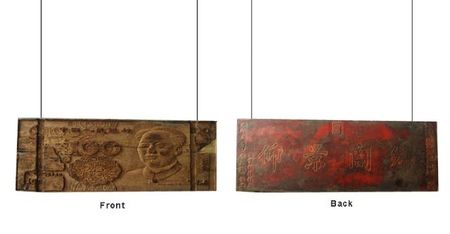"Eastern Promise: Contemporary Art from China" @ Lisa Sette Gallery
Huang Binyan, Rabbit #5, 2007
This past year has been a seminal time for China, with the country seldom far from the headlines of the world’s press. No one can deny the success of Beijing’s staging of the Olympics, and now the newest superpower races towards achievements in space. The state of the world economy offers further room for bolstering China’s new standing, and within the country, there is huge promise for those who can ride the wave of the boom. Yet behind it all, there is continued unrest as those left behind have to struggle even for life’s basics, and as corruption and lack of quality control have led to tragedy in the earthquake zone and in daily industrial accidents, not to mention to serious damage in China’s reputation in both domestic and world markets.
Li Mingzhu, Renminbi, 2008
Ironically, these contrasts provide much of the continued dynamism in the contemporary art scene. A local market has developed amongst the burgeoning numbers of the wealthy, and it is largely this that has led to prices for the best-recognized names to be driven ever more stratospheric, thus stimulating further interest in the wider art world. This growing interest and concomitant income has enabled artists to enjoy experimentation with works often huge in scale and breathtaking in ambition, safe in the knowledge that there will be space for exhibition given that the large number of new galleries and art centers ensure some desire for innovation as well as commercial success.
Liu Bolin, Hiding in the City #46, Whole Happy Family 2, 2006
Yet if it is wealth that brings the art to market, it is the dark side of the boom that tends to provide the content. With its assemblage of emerging artists together with some of their more established peers, Eastern Promise: Contemporary Art from China offers a vision of the themes that concern most artists in China today.
Luo Brothers, Welcome to the World's Famous Brands, 2008
Chief amongst these remains the idea of the supremacy of power of government and the inevitable subjugation of the individual. This is of course not new to post-1980’s art in China, but it does reflect the fact that even in the information age, with its multiple conduits for new ideas and images, the government is as controlling as ever. So in the works of both the older artists (Qu Yan, b.1955, and Suo Tan, b.1962) and some of the youngest (Li Mingzhu, b. 1973, and Zheng Li, b.1976) Mao features prominently – to most Chinese he remains the archetypal symbol of power. Liu Bolin (b.1973) paints himself into the Chinese national flag to suggest that even artists are not immune to the vagaries of governmental decree, whereas Zhang Dali (b.1963) composes the face of an anonymous individual from repeated yet differing shades of the symbol of the Chinese military assault rifle – AK-47 – to broaden the target to Everyman.
Xue Song, Will Shine Forever, 2007
The power of government in China may be well documented and therefore widely known amongst even the most casual visitor to the country, but it is certainly not as highly visible as the second of the themes that emergeswithin the work of the artists represented here. Nobody visiting a major Chinese city today could fail to notice the impact of consumer culture in China. Unsurprising therefore that the ubiquitous gloss and tack is commented upon in many art forms, but interesting that it is presented most effectively in the most traditional media of lacquer (Luo Brothers, b.1963, 1964, 1972) and ceramic (Li Mingzhu), as well as in photography (Qu Yan, Tong Dazhuang b.1977) and bronze (Chen Wenling b.1969). Li Mingzhu has also explored the theme in a novel way through his newest work ‘Renminbi’, in which he has carved a Chinese 100 yuan banknote onto the back side of a wooden memorial plaque dating from 1876. China’s tradition itself has become bankable.
Yu Fan, Boyhood 1 Blue, 2008
The increase in references to international art history shows that Western tradition, too, is now much better understood. Art History courses in Chinese academies have always been thorough but now frequent exhibitions in China of international artists as well as the busy travel schedules of many Chinese artists have led to a far wider familiarity with images. Andy Warhol has always been popular, in part because of the fascination with his useof the Mao image, and Marcel Duchamp has provided inspiration in China as much as anywhere for the more conceptual artist, but now Jeff Koons makes his appearance too. Tellingly, it is the youngest artist in the exhibition, Huang Binyan (b.1984), who has appropriated Koons’ Rabbit, slip-cast now in ceramic and intricately painted with traditional Chinese blue on white. As with her ceramic urinal “Cover #2” with its laboriously sculpted flowers, the work could not be further from the conceit of the original artists. And therein lies the promise... - Thomas J. Whitten
Artists included in the exhibition are: Chen Wenling, Huang Binyan, Li Mingzhu, Liu Bolin, Luo Brothers, Mu Jun, Qu Yan, Suo Tan, Tong Dazhuang, Wang Dajun, Wang Nengtao, Wang Zhiyuan, Xiang Xiaoli, Xue Song, Yu Fan, Zhang Dali, and Zheng Li.
Nov 6 - Jan 3, 2008 - Lisa Sette Gallery www.lisasettegallery.com
Zheng LI, The King and the Little Bird, 2008

/https%3A%2F%2Fprofilepics.canalblog.com%2Fprofilepics%2F1%2F0%2F100183.jpg)
/https%3A%2F%2Fstorage.canalblog.com%2F03%2F02%2F119589%2F96711876_o.jpg)
/https%3A%2F%2Fstorage.canalblog.com%2F11%2F31%2F119589%2F94773502_o.jpg)
/https%3A%2F%2Fstorage.canalblog.com%2F20%2F83%2F119589%2F94772815_o.jpg)
/https%3A%2F%2Fstorage.canalblog.com%2F26%2F72%2F119589%2F75604929_o.jpg)
/https%3A%2F%2Fstorage.canalblog.com%2F59%2F60%2F119589%2F26458628_o.jpg)









/image%2F1371349%2F20240418%2Fob_ac5c4c_telechargement.jpg)
/image%2F1371349%2F20240418%2Fob_709b64_304-1.jpg)
/image%2F1371349%2F20240418%2Fob_22f67e_303-1.jpg)
/image%2F1371349%2F20240417%2Fob_9708e8_telechargement.jpg)